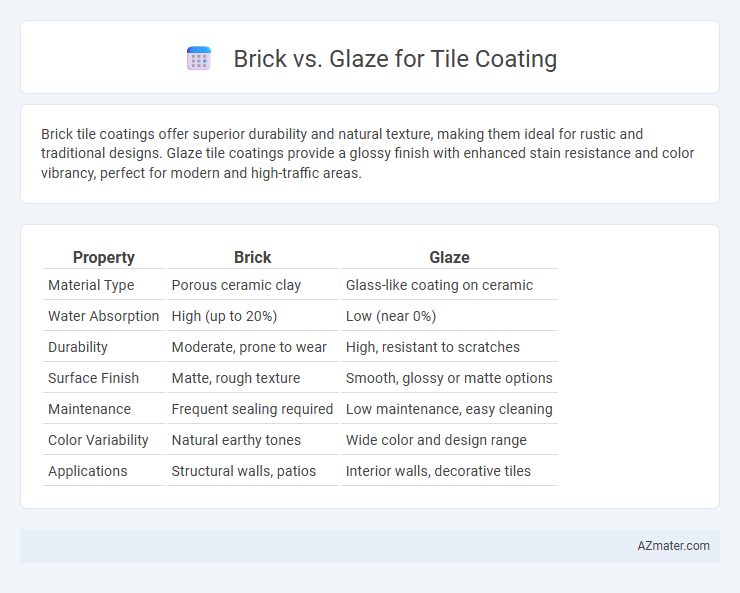Brick tile coatings offer superior durability and natural texture, making them ideal for rustic and traditional designs. Glaze tile coatings provide a glossy finish with enhanced stain resistance and color vibrancy, perfect for modern and high-traffic areas.
Table of Comparison
| Property | Brick | Glaze |
|---|---|---|
| Material Type | Porous ceramic clay | Glass-like coating on ceramic |
| Water Absorption | High (up to 20%) | Low (near 0%) |
| Durability | Moderate, prone to wear | High, resistant to scratches |
| Surface Finish | Matte, rough texture | Smooth, glossy or matte options |
| Maintenance | Frequent sealing required | Low maintenance, easy cleaning |
| Color Variability | Natural earthy tones | Wide color and design range |
| Applications | Structural walls, patios | Interior walls, decorative tiles |
Introduction to Brick and Glaze Tile Coatings
Brick tile coatings offer a porous and textured surface that enhances grip and natural aesthetics, ideal for rustic or traditional settings. Glaze tile coatings provide a smooth, glossy finish that increases durability and stain resistance, making them suitable for modern, high-traffic areas. Both coatings influence the tile's appearance and maintenance requirements, with brick emphasizing natural appeal and glaze prioritizing protection and shine.
Composition and Properties of Brick Tile Coating
Brick tile coatings primarily consist of natural clay minerals combined with sand, giving them exceptional durability and breathability. These coatings provide excellent thermal insulation and moisture resistance due to their porous structure, making them ideal for outdoor applications. Unlike glaze coatings, brick coatings offer a matte finish with better resistance to chipping and weathering over time.
Understanding Glaze: Materials and Application
Glaze for tile coating is a thin layer of glass-like substance composed primarily of silica, fluxes, and colorants that fuses to the tile surface during high-temperature firing. This coating enhances tile durability, provides water resistance, and offers a wide range of aesthetic finishes from matte to glossy. Unlike brick, ceramic tile glaze requires precise kiln firing to achieve its vitrified, protective layer that not only seals the tile but also impacts color consistency and surface texture.
Aesthetic Differences: Brick vs Glaze
Brick tile coatings offer a natural, rustic appearance characterized by textured surfaces and earthy color variations, enhancing warmth and a traditional aesthetic. Glaze tile coatings provide a smooth, glossy finish with vibrant color options and reflective qualities, contributing to a sleek, modern look. The choice between brick and glaze significantly affects the visual impact, with brick emphasizing tactile depth and glaze highlighting shine and color uniformity.
Durability and Longevity Comparison
Brick tile coatings offer exceptional durability, with resistance to chipping, cracking, and weathering, making them ideal for high-traffic areas and outdoor applications. Glaze coatings provide a harder surface with superior stain resistance and ease of cleaning but may be more susceptible to crazing and surface wear over time. When comparing longevity, brick coatings generally maintain structural integrity longer under physical stress, while glazed tiles preserve aesthetic appeal through their glossy finish but can show wear faster in heavy-use environments.
Maintenance Requirements and Cleaning
Brick tile coatings demand frequent maintenance to prevent moisture absorption and efflorescence, requiring regular sealing and scrubbing with mild detergents to preserve appearance. Glaze tile coatings offer superior resistance to stains and water penetration, significantly reducing the need for intensive cleaning and maintenance over time. Their smooth, non-porous surface allows for easy removal of dirt and grime using standard household cleaners without compromising the finish.
Cost Analysis: Brick vs Glaze Tile Coatings
Brick tile coatings generally cost less upfront, averaging $5 to $15 per square foot, while glaze coatings range from $10 to $25 per square foot due to more complex application and higher-quality materials. The durability of glaze coatings often reduces long-term maintenance expenses, making them more cost-effective over time despite the higher initial investment. Brick coatings may require more frequent resealing or repairs, increasing overall expenditure in comparison to the low-maintenance properties of glazed surfaces.
Environmental Impact and Sustainability
Brick tile coatings typically have a lower environmental impact due to their natural composition and minimal processing requirements, which reduces carbon emissions during manufacturing. Glaze coatings, while offering enhanced durability and aesthetics, often involve chemical treatments and high-temperature firing that increase energy consumption and release volatile organic compounds (VOCs). Sustainable tile production favors brick coatings for their biodegradability and reduced ecological footprint, though innovations in low-impact glaze technologies are gradually improving their environmental performance.
Suitable Applications for Brick and Glaze Coatings
Brick coatings excel in outdoor environments due to their durability and resistance to weathering, making them ideal for patios, walkways, and exterior walls. Glaze coatings, with their smooth and glossy finish, are best suited for indoor applications such as bathroom walls, kitchen backsplashes, and decorative tiles that require stain resistance and easy cleaning. Both coatings provide distinct benefits: brick coatings enhance structural protection, while glaze coatings offer aesthetic appeal and moisture resistance in interior settings.
Choosing the Right Coating: Key Considerations
Selecting the right tile coating between brick and glaze hinges on factors like durability, aesthetic appeal, and maintenance requirements. Brick coatings offer a rustic, textured finish that withstands wear and outdoor conditions, making them ideal for high-traffic or exterior spaces. In contrast, glazed tiles provide a smooth, glossy surface that resists stains and moisture, suited for indoor applications requiring easy cleaning and vibrant color retention.

Infographic: Brick vs Glaze for Tile Coating
 azmater.com
azmater.com